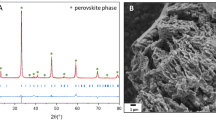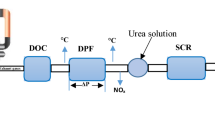Abstract
Diesel engines are the most extensively used power source in automobiles and stationary power generation. The main drawback of using diesel engines is that it liberates a significant amount of NOx and PM emissions in the exhaust. NOx emission has a serious effect on the environment, and it has to be controlled effectively. SCR is the most widely used after-treatment technology to control NOx emission, but it has various disadvantages like ammonia slip and degradation of the catalyst. In this study, electrochemical decomposition of NOx is proposed for the simultaneous control of NOx, HC, and CO emissions in a diesel engine. In this work, ionically conducting ceramic electrochemical cells are investigated for control of diesel exhaust emissions. The electrochemical cell consisting of yttrium stabilized zirconia (YSZ) substrate plates as electrolyte and Ag-YSZ and NiO-YZS as an electrode material. The decomposition of NOx in an electrochemical cell is attained by passing electric current. A 2V supply of power was sufficient for effective operation of the electrochemical cell in all load conditions. All the experiments were conducted in a single-cylinder diesel engine. It is observed that the electrochemical cell shows high NOx decomposition rate of 80% at the exhaust temperatures between 350 and 400 °C. The HC reduction up to 65% and CO reduction up to 45% was observed with this technique. The power required to operate the electrochemical cell was low. The electrochemical NOx reduction is relatively simple technology with reduced complexity. From the experiment, it is observed that this concept works efficiently in the oxygen-rich diesel exhaust.













Similar content being viewed by others
Abbreviations
- NOx:
-
oxides of nitrogen
- HC:
-
hydrocarbon
- CO:
-
carbon monoxide
- PM:
-
particulate matter
- YSZ:
-
yttrium stabilized zirconia
- NiO:
-
nickel oxide
- Ag:
-
silver
- ECM:
-
electronic control module
- SEM:
-
scanning electron microscopy
- EDX:
-
energy-dispersive X-ray spectroscopy
- ECD:
-
electrochemical cell device
References
Aggarwal SK, Fu X, Wijeyakulasuriya S (2016) Effects of fuel reactivity and injection timing on diesel engine combustion and emissions. International Journal of Green Energy 13(5):431–445
Awano M, Bredikhin S, Aronin A, Abrosimova G, Katayama S, Hiramatsu T (2004) NOx decomposition by electrochemical reactor with electrochemically assembled multilayer electrode. Solid State Ionics 175(1–4):605–608
Bredikhin S, Maeda K, Awano M (2001a) Electrochemical cell with two layers cathode for NO decomposition. Ionics 7(1–2):109–115
Bredikhin S, Maeda K, Awano M (2001b) NO decomposition by an electrochemical cell with mixed oxide working electrode. Solid State Ionics 144(1–2):1–9
Bredikhin S, Maeda K, Awano M (2002) Low current density electrochemical cell for NO decomposition. Solid State Ionics 152:727–733
Casselton REW (1974) Blackening in yttria stabilized zirconia due to cathodic processes at solid platinum electrodes. J Appl Electrochem 4(1):25–48
Cheng S, Liu H, Logan BE (2006) Increased performance of single-chamber microbial fuel cells using an improved cathode structure. Electrochem Commun 8(3):489–494
Driese SG, Foreman JL (1991) Traces and related chemical changes in a Late Ordovician paleosol, Glossifungites ichnofacies, southern Appalachians, USA. Ichnos: An International Journal of Plant & Animal 1(3):207–219
Fang HL, DaCosta HF (2003) Urea thermolysis and NOx reduction with and without SCR catalysts. Appl Catal B Environ 46(1):17–34
Gür TM, Huggins RA (1979) Decomposition of nitric oxide on zirconia in a solid-state electrochemical cell. J Electrochem Soc 126(6):1067–1075
Hamamoto K, Fujishiro Y, Awano M (2006) Simultaneous removal of nitrogen oxides and diesel soot particulate in nano-structured electrochemical reactor. Solid State Ionics 177(26–32):2297–2300
Hamamoto K, Fujishiro Y, Awano M (2007) NOx decomposition using electrochemical reactor. In Meeting Abstracts (No. 11, pp. 800-800). In: The Electrochemical Society
Hansen KK (2018) Electrochemical removal of NOx using oxide-based electrodes-a review. Int J Electrochem Sci 13(10):9273–9280
Hernández WY, Hadjar A, Klotz M, Leloup J, Princivalle A, Tardivat C et al (2013) NOx storage capacity of yttria-stabilized zirconia-based catalysts. Appl Catal B Environ 130:54–64
Heywood, J. B. (1988). Internal combustion engine fundamentals
Hill SC, Smoot LD (2000) Modeling of nitrogen oxides formation and destruction in combustion systems. Prog Energy Combust Sci 26(4–6):417–458
Hoekman SK, Robbins C (2012) Review of the effects of biodiesel on NOx emissions. Fuel Process Technol 96:237–249
Holman JP, Walter J (2001) Experimental methods for engineers. McGraw-Hill, New York
IEA (2012) Emission from fuel combustion. Internal Energy Agency 13:2895–2902
İlkiliç C, Aydin H (2012) The harmful effects of diesel engine exhaust emissions. Energy Sources, Part A: Recovery, Utilization, and Environmental Effects 34(10):899–905
Janek J, Korte C (1999) Electrochemical blackening of yttria-stabilized zirconia–morphological instability of the moving reaction front. Solid State Ionics 116(3–4):181–195
Kašpar J, Fornasiero P, Hickey N (2003) Automotive catalytic converters: current status and some perspectives. Catal Today 77(4):419–449
Kammer K (2005) Electrochemical DeNOx in solid electrolyte cells—an overview. Appl Catal B Environ 58(1–2):33–39
Kline SJ, McClintock FA (1953) Describing uncertainties in single-sample experiments. Mech Eng 75(1):3–8
Li X, Vernoux P (2005) A new NOx storage-reduction electrochemical catalyst. Appl Catal B Environ 61(3–4):267–273
Maurer, M., Holler, P., Zarl, S., Fortner, T., & Eichlseder, H. (2017). Investigations of lean NOx trap (LNT) regeneration strategies for diesel engines (no. 2017-24-0124). SAE Technical Paper
Mohankumar S, Senthilkumar P (2017) Particulate matter formation and its control methodologies for diesel engine: a comprehensive review. Renew Sust Energ Rev 80:1227–1238
Muthiya SJ, Pachamuthu S (2018) Electrochemical NOx reduction and oxidation of HC and PM emissions from biodiesel fuelled diesel engines using electrochemically activated cell. International journal of green energy 15(5):314–324
Pancharatnam S, Huggins RA, Mason DM (1975) Catalytic decomposition of nitric oxide on zirconia by electrolytic removal of oxygen. J Electrochem Soc 122(7):869–875
Park S, Song HS, Choi HJ, Moon J (2004) NO decomposition over the electrochemical cell of lanthanum stannate pyrochlore and YSZ composite electrode. Solid State Ionics 175(1–4):625–629
Parthiban K, Pazhanivel K, Muthiya SJ (2017) Emission control in multi-cylinder spark ignition engines using metal-oxide coated catalytic converter. International Journal of Vehicle Structures & Systems 9(2):134
Quevauviller P (2011) Adapting to climate change: reducing water-related risks in Europe–EU policy and research considerations. Environ Sci Pol 14(7):722–729
Sajjad F, Noreen U, Zaman K (2014) Climate change and air pollution jointly creating nightmare for tourism industry. Environ Sci Pollut Res 21(21):12403–12418
Schefold J, Brisse A, Zahid M (2009) Electronic conduction of yttria-stabilized zirconia electrolyte in solid oxide cells operated in high temperature water electrolysis. J Electrochem Soc 156(8):B897–B904
Subramaniam, M., Pachamuthu, S., Arulanandan, J., & Muthiya, J. (2016). Simultaneous reduction of HC, NO x and PM by using active regeneration technique (no. 2016-01-0912). SAE Technical Paper
Sun J, Caton JA, Jacobs TJ (2010) Oxides of nitrogen emissions from biodiesel-fuelled diesel engines. Prog Energy Combust Sci 36(6):677–695
Theis JR, Kim J, Cavataio G (2015) TWC + LNT/SCR systems for satisfying tier 2, bin 2 emission standards on lean-burn gasoline engines. SAE International Journal of Fuels and Lubricants 8(2):474–486
Vallapudi DR, Makineni HK, Pisipaty SK, Venu H (2018) Combined impact of EGR and injection pressure in performance improvement and NOx control of a DI diesel engine powered with tamarind seed biodiesel blend. Environ Sci Pollut Res 25(36):36381–36393
Xi Wang. (2019) Effects of the Ba impregnation on Pt electrode on NO electrochemical reduction mechanism. International Journal of Economy, Energy and Environment, 4 (2) 24-32. Dio:https://doi.org/10.11648/j.ijeee.20190402.11
Yoshinobu Y, Tsuda Y, Ueda H, Nakanishi Y, Gong J (2010) Simultaneous reduction of NOx and PM in diesel exhaust based on electrochemical reaction. SAE International Journal of Fuels and Lubricants 3(1):50–60
Zhang J, Li Y, Zhang Y, Chen M, Wang L, Zhang C, He H (2015) Effect of support on the activity of Ag-based catalysts for formaldehyde oxidation. Sci Rep 5:12950
Author information
Authors and Affiliations
Corresponding author
Additional information
Responsible editor: Bingcai Pan
Publisher’s note
Springer Nature remains neutral with regard to jurisdictional claims in published maps and institutional affiliations.
Rights and permissions
About this article
Cite this article
Solomon, J.M., Pachamuthu, S., Arulanandan, J.J. et al. Electrochemical decomposition of NOx and oxidation of HC and CO emissions by developing electrochemical cells for diesel engine emission control. Environ Sci Pollut Res 27, 32229–32238 (2020). https://doi.org/10.1007/s11356-019-07327-9
Received:
Accepted:
Published:
Issue Date:
DOI: https://doi.org/10.1007/s11356-019-07327-9




